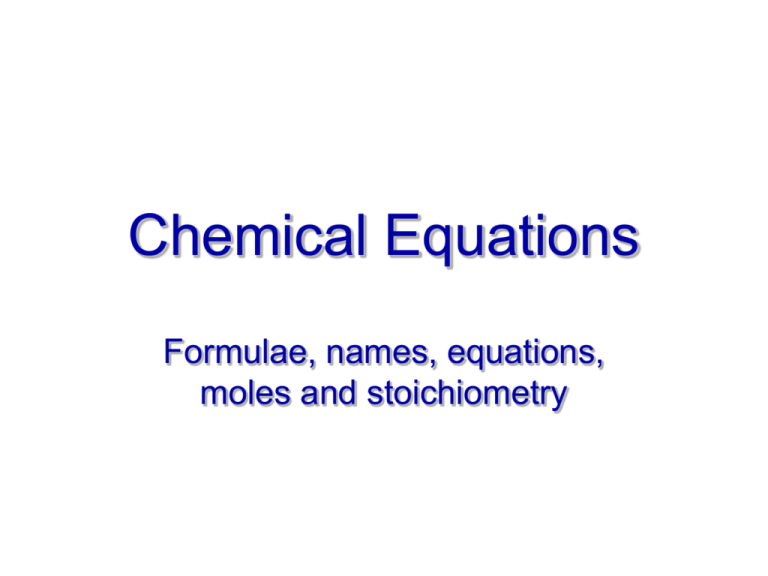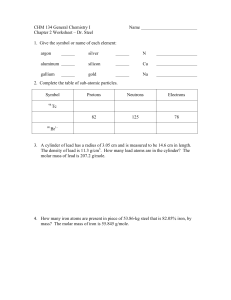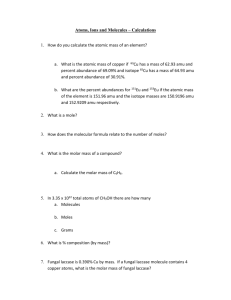Compounds (download)
advertisement

Chemical Equations Formulae, names, equations, moles and stoichiometry Learning objectives Write chemical formulae for substances Write names for simple compounds Apply conservation of matter to balance simple chemical equations Define the “mole” Calculate molar mass of compounds Apply the mole concept to chemical reactions Describe concentration using molarity, percent and ppm Most substances are compounds Two or more elements combined Constant Composition: Compound always contains same amount of each element Chemical formula tells us the number of atoms of each element Water is H2O Chemical formula: the use of subscripts Ionic compound: Formula tells us ratio of the elements • NaCl (Na:Cl = 1:1) • CaCl2 (Ca:Cl = 1:2) Covalent compound: Formula tells us number of atoms in molecule • C12H22O11 – 12 C atoms, 22 H atoms, 11 O atoms Formulae and counting atoms Ionic and covalent Ionic (sodium chloride) contain ions Charged particles Electron transfer Solutions conduct electricity (electrolytes) Covalent (sugar) contain molecules No charged particles Atoms share electrons Solutions don’t conduct electricity Covalent molecules and molecular formula Molecular formula gives number of atoms in molecule Benzene is C6H6 Simplest formula would be CH But so is acetylene C2H2 Molecules can contain thousands of atoms – each one plays a role Naming ionic simple compounds Simple ionic compounds contain positive metal ion (cation) and negative nonmetal ion (anion) Metal goes first, name unchanged Nonmetal second, name ending → ide Subscripts are not named • Sodium and chlorine → sodium chloride NaCl • Potassium and oxygen → potassium oxide K2O • Calcium and fluorine → calcium fluoride CaF2 Anions and polyatomic ions Naming covalent compounds There are no metals: what’s the order? More “metallic” one first Less “metallic” one second, end → ide Subscripts are stated (except if first one is one) • CO2 Carbon dioxide • N2O Dinitrogen monoxide • P2O5 Diphosphorous pentoxide Counting particles: The Mole The mole is a unit of quantity used in chemistry to measure the number of atoms or molecules DEFINITION: The number of atoms in exactly 12 g of 12C A mole of anything always has the same number of particles: atoms, molecules or potatoes – 6.02 x 1023 – Avogadro’s number Atomic and molecular masses Two scales: Atomic mass unit scale The mass of an individual atom or molecule in atomic mass units (amu) Molar mass scale The mass of a mole of atoms or molecules in grams Confusing? The Good News The mass of a single atom in amu has the same numerical value as its molar mass in grams The atomic mass of carbon is 12 amu The molar mass of carbon is 12 g The same is true for molecules and compounds The formula mass of H2O is 18 amu The molar mass of H2O is 18 g Examples How many moles are in 13.88 g of lithium if the atomic mass of Li is 6.94 amu? 2.00 What is the molar mass of CH4 if the atomic mass of H = 1 amu and C = 12 amu 16 g Some molar mass examples





